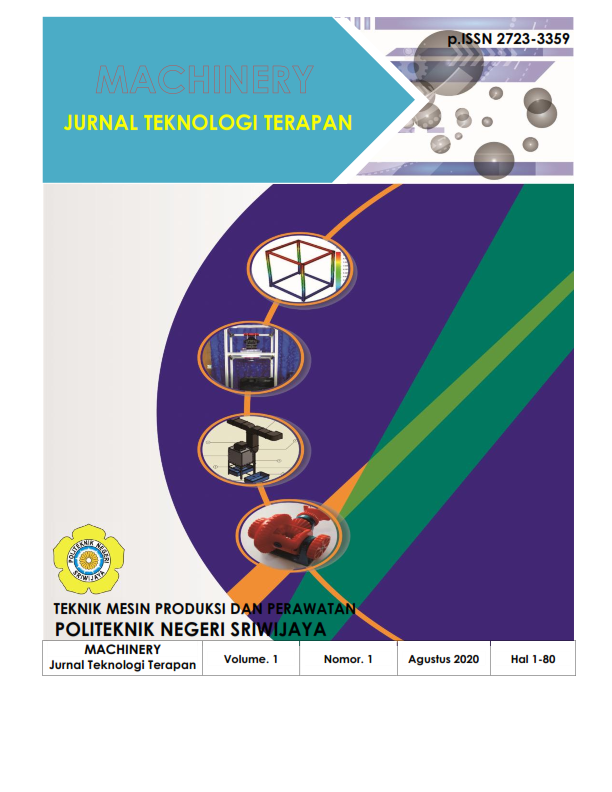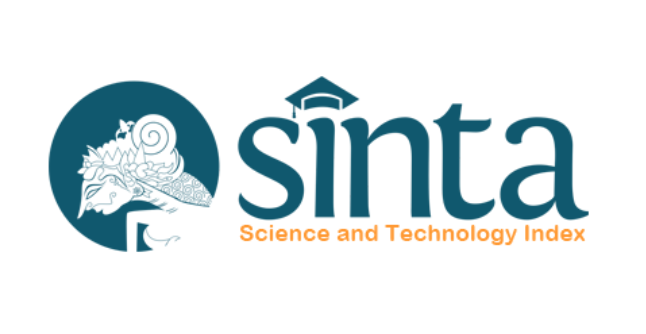Retracted Article: PENGARUH PARAMETER PROSES 3D PRINTER TEKNOLOGI DIGITAL LIGHT PROCESSING TERHADAP GEOMETRIS POROS
DOI:
https://doi.org/10.5281/zenodo.4540908Keywords:
3DP-DLP, ANOVA, Layer Thickness, Exposure Time, Cylindricity.Abstract
Perkembangan teknologi Industri 4.0 yang ditandai dengan cyber-physical systems. Era ini mempermudah manusia terkoneksi dengan manusia lain, dengan mesin-mesin industri, maupun dengan lingkungan disekitarnya. Dengan adanya revolusi industri 4.0 ini dapat meningkatkan produktivitas secara signifikan. pada masa ini sering kali dibutuhkan produk single part, dimana produk yang digunakan hanya sedikit dan tanpa perlu produksi masal atau bersifat custom design. Produk yang bersifat custom design dapat dibuat dengan mesin 3D Printer (3DP). 3D Printing adalah salah satu teknologi terbaru di dunia percetakan, dimana mudahnya teknologi percetakan 3D dalam melakukan pencetakan dan pengembangan solid produk dengan teknologi 3DP ini. Dalam penelitian ini, pencetakan objek menggunakan 3DP melalui data CAD yang kemudian diubah menjadi G-Code dengan perangkat lunak Creation Workshop versi 1.0.0.75. Penelitian ini bertujuan untuk mengetahui pengaruh layer thickness dan exposure time terhadap geometris Poros yang dibuat menggunakan 3D Printer teknologi Digital Light Processing (DLP). Spesimen yang diuji berukuran Ø20 x 100 mm dengan material Liquid Photopolymer Resin. Data hasil pengujian dianalisis menggunakan ANOVA dengan tipe desain 3 tingkat dan 2 interaksi faktorial (2FI) dengan 3 replikasi yang dimodelkan oleh perangkat lunak Design-Expert® 10 trial version. Hasil analisis keselindrisian metode 5 titik menunjukkan bahwa faktor utama yang paling berpengaruh terhadap keselindrisan spesimen uji adalah faktor layer thickness, dan kombinasi parameter yang paling optimal pada penelitian ini adalah layer thickness 0,075 mm dan exposure time 15 second..Â
Downloads
References
Bourel, D., Beaman, J., Leu, M., & Rosen, D. (2009). 04. RAPID History of AM and 2009 Roadmap. RapidTech 2009: US-TURKEY Workshop on Rapid Technologies, 1–8.
Kodama, H. (1981). Automatic method for fabricating a three-dimensional plastic model with photo-hardening polymer. Review of Scientific Instruments, 52(11), 1770–1773. https://doi.org/10.1063/1.1136492
ISO 1101:2017 Geometrical product specifications (GPS) — Geometrical Tolerancing — Tolerances of Form, Orientation, Location and Run-out.
ISO 12180-1:2011 Geometrical product specifications (GPS) — Cylindricity — Part 1: Vocabulary and parameters of cylindrical form.
Lu, B., Li, D., & Tian, X. (2015). Development Trends in Additive Manufacturing and 3D Printing. Engineering, 1(1), 085–089. https://doi.org/10.15302/J-ENG-2015012
Mahamood, S., Khader, M. A., & Ali, H. (2016). Applications of 3-D Printing in Orthodontics : A Review. International Journal of Scientifi c Study, 3(11), 267–270. https://doi.org/10.17354/ijss/2016/99
Philip J. Ross. (1989). Taguchi Techiques For Quality Engineering. International Edition, McGraw Hill Book Co, New York.
Rinanto, A., & Sutopo, W. (2017). Perkembangan Teknologi Rapid Prototyping : Study Literatur. 18, 105–112.
Rochim, T. (2010). Teknik Pengukuran (Metrologi Industri). Bandung: Lab Metrologi Institut Teknologi bandung
Romli, Seprianto, D., Putra, D. P., Zamheri, & Rasid, M. (2020). The Effect of Parameters on the Process of Making Objects with Rapid Prototyping Digital Light Processing Technology on the Bending Stress. Journal of Physics: Conference Series, 1500(1). https://doi.org/10.1088/1742-6596/1500/1/012027
Satankar, R. K. (2017). Investigating the process parameters of 3D printer extruder of Fused Deposition Modeling- A review. Journal of Emerging Technologies and Innovative Research, 4(10), 1–9.
Seprianto, D., Iskandar, Wilza, R., & Adesta, E. Y. T. (2019). Influence of internal fill pattern, polishing time and Z-Axis orientation on the tensile strength of the 3D printed part. International Journal of Recent Technology and Engineering, 7(6), 170–174.
Seprianto, Dicky, & Wilza, R. (2017). Optimasi Parameter Pada Proses Pembuatan Objek 3D Printing Dengan Teknologi FDM Terhadap Akurasi Geometri. November, 37–49.
Setiawan, A. A., Karuniawan, B. W., & Arumsari, N. (2018). Optimasi Parameter 3D Printing Terhadap Keakuratan Dimensi dan Kekasaran Permukaan Produk Menggunakan Metode Taguchi Grey Relational Analysis. Proceedings Conference on Design Manufacture Engineering and Its Application Program, 2654.
Simm, A., Wang, Q., Huang, S., & Zhao, W. (2016). Laser based measurement for the monitoring of shaft misalignment. Measurement: Journal of the International Measurement Confederation, 87, 104–116. https://doi.org/10.1016/j.measurement.2016.02.034
Sudjana. (1994). Desain Dan Analisis Eksperimen. Edisi III, Tarsito. Bandung.
ValentinÄiÄ, J., PeroÅ¡a, M., Jerman, M., Sabotin, I., & Lebar, A. (2017). Low cost printer for DLP stereolithography. Strojniski Vestnik/Journal of Mechanical Engineering, 63(10), 559–566. https://doi.org/10.5545/sv-jme.2017.4591
Water, N. (2018). Vibration Analysis and Infrared Thermography Technique for. 5(1), 76.
Downloads
Published
How to Cite
Issue
Section
License
Copyright (c) 2021 Authors and Publisher

This work is licensed under a Creative Commons Attribution-NonCommercial-NoDerivatives 4.0 International License.
The Authors submitting a manuscript do so on the understanding that if accepted for publication, copyright of the article shall be assigned to MACHINERY: Jurnal Teknologi Terapan as publisher of the journal. Copyright encompasses rights to reproduce and deliver the article in all form and media, including reprints, photographs, microfilms, and any other similar reproductions, as well as translations.Â
MACHINERY: Jurnal Teknologi Terapan and the Editors make every effort to ensure that no wrong or misleading data, opinions or statements be published in the journal. In any way, the contents of the articles and advertisements published in MACHINERY: Jurnal Teknologi Terapan are the sole responsibility of their respective authors and advertisers.








